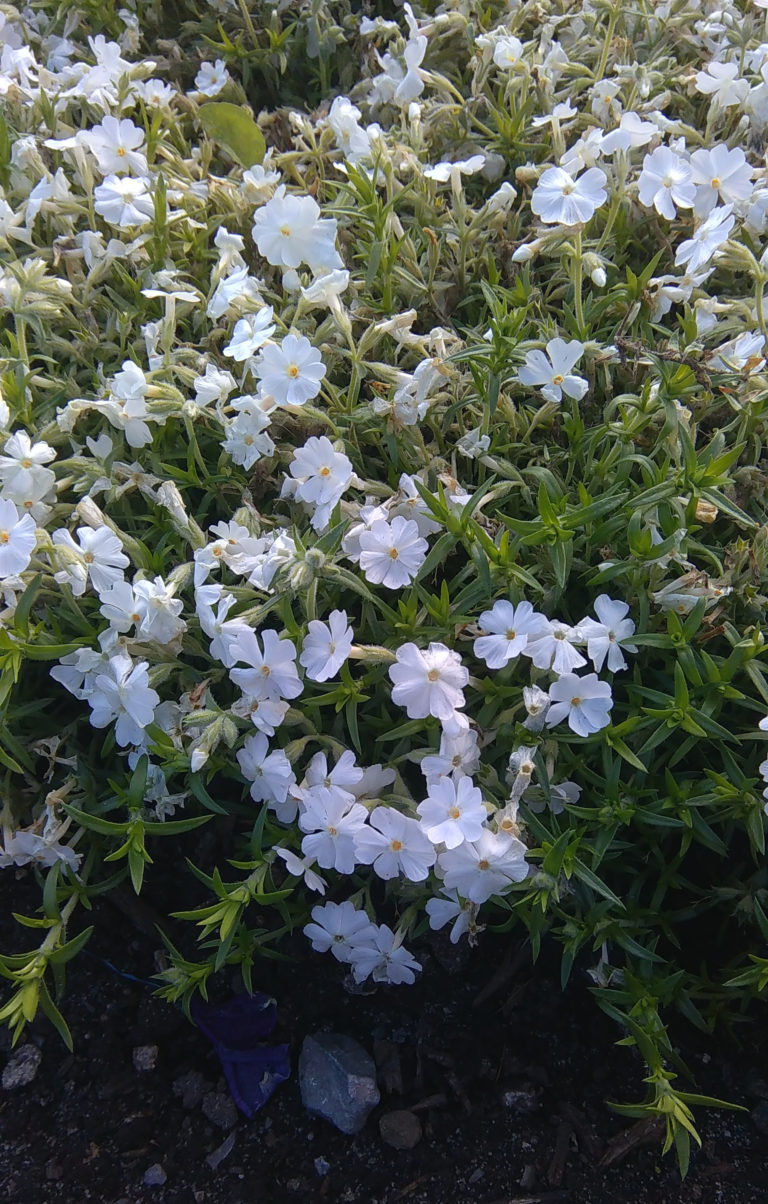Phlox nivalis, or Traliling Phlox, is a low growing, early flowering, sun-loving species of Phlox which presents as a mound-forming mat of stiff, needle-like, evergreen foliage. Although reported in all three NC zones (mountains, piedmont, coastal plain) its strongest presence appears to be in sandhill and dry habitats of the central counties of NC and South Carolina. Hence it is tolerant of dry conditions. It forms a 6-inch mat, with woody trailing stems — some call it a subshrub. In May and June it produces typical Phlox flowers (five flattened petal lobes fused at the base in a long tube) with blossoms from purple to pink to white, usually pink, with nectar guide markings at the base of the petal lobes. What differentiates Trailing Phlox from other groundcover Phloxes, for instance P. subulata, is its semi-woody nature (P. subulata is entirely herbaceous); it flowers several weeks ahead of P. subulata; and in details of its floral structure (see Flowers). Also, P. nivalis prefers acidic, sandy soil whereas P. subulata prefers rocky, more alkaline soil. Trailing Phlox is a tough and hardy groundcover that draws many pollinators, including hummers, and lifts the color display of the garden in early summer.
NURSERY HOURS
Wednesday: 10-4 Thursday: 10-6 Friday-Saturday: 10-4 Sunday: 12-4
Phlox nivalis

Key Info
Common Names: Sweet Trailing Phlox, Pineland Phlox
Family Names: Polemoniaceae (Jacob's Ladder Family)
Leaf Retention: Evergreen
Flower Color: Pink to rose to lavender, rarely white
Special Characteristics: Tolerates dry conditions, Attracts butterflies, Candidate for fire management, Attracts Hummingbirds
Additional Info
Habit: Low growing, evergreen, mound-forming subshrub or semi-woody perennial, sends out low runners; can be identified by its woody, trailing stems though the flowering stems are erect, herbaceous and deciduous.
Height: 6" - 8"
Spread: 1.5'
Soil Conditions: Medium to dry, well drained; acidic, sandy.
Leaves: 6-8" mat of shiny, dense, needle-like foliage, evergreen. Leaves are opposite or in fascicles on short axillary spur shoots.
Flowers (or reproductive structures: Many pink to purple (rarely white) flowers at the top of each short flower stalk. Flowers are fragrant, about 1 inch across, 5-petaled with petals fused around a narrow throat. Petals are irregularly toothed and have colorful nectar guide markings at the base of the flattened, visible lobe. The style within the tube is so short in P. nivalis that the stigma is at the bottom of the tube. (In P. subulata the style reaches end of the tube. i.e., the stamens are exserted.)
Fruit: The rounded fruits starts out green and eventually (late summer/fall) dry to brown, ovoid seed capsules containing several small black seeds.
Natural Distribution: Sandhills, dry pinelands, dry deciduous woods, open slopes and flats in sandy ground.
USDA Hardiness Zone: 3 to 8
USDA Wetland Indicator Status in NC: not available
Pollination: Long tongued insects (butterflies, some bees, other insects) and hummingbirds.
Wildlife Connections: Attracts many pollinators.
Propagation: By division or by cuttings.
